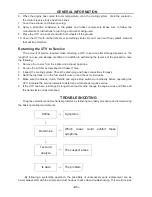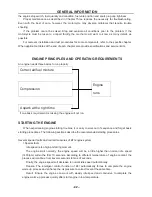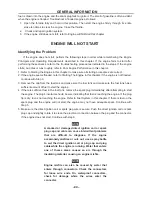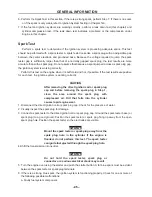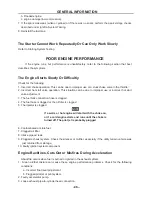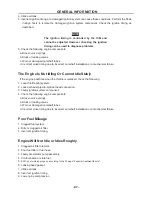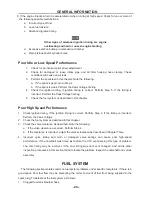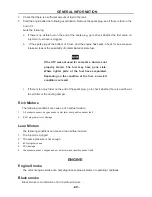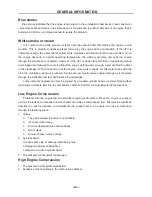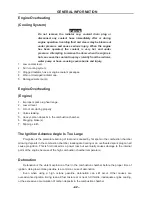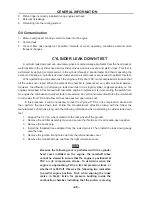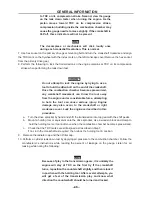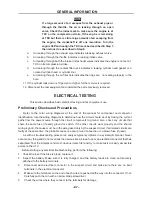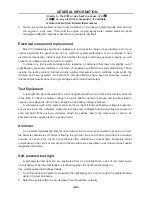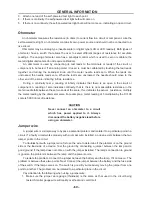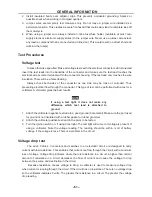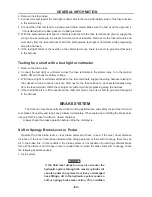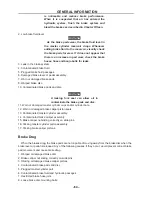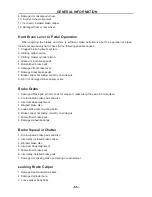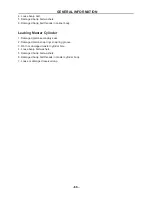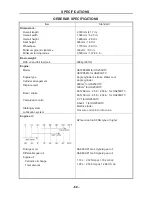
-43-
GENERAL INFORMATION
- 43 -
Continued detonation can result in engine damage.
Power Loss
Refer to Poor Engine Performance in this chapter.
Engine Noises
Unusual noises are often the first indication of a developing problem. Investigate any new noises
as soon as possible. Something that may be a minor problem, if corrected, could prevent the
possibility of more extensive damage.
Use a mechanic’s stethoscope or a small section of hose held near your ear (not directly on your
ear) with the other end close to the source of the noise to isolate the location. Determining the exact
cause of a noise can be difficult. If this is the case, consult with a professional mechanic to determine
the cause. Do not disassemble major components until all other possibilities have been eliminated.
Consider the following when troubleshooting engine noises:
1. Knocking or pinging during acceleration can be caused by using a lower octane fuel than
recommended. May also be caused by poor fuel. Pinging can also be caused by an incorrect
spark plug heat range or carbon buildup in the combustion chamber.
2. Slapping or rattling noises at low speed or during acceleration—May be caused by excessive
piston-to-cylinder wall clearance (piston slap).
NOTE
Piston slap is easier to detect when the engine is
cold and before the piston has expanded. Once
the engine has warmed up, piston expansion
reduces piston-to-cylinder clearance.
3. Knocking or rapping while decelerating—Usually caused by excessive rod bearing clearance.
4. Persistent knocking and vibration occurring every crankshaft rotation—Usually caused by
worn rod or main bearing(s). Can also be caused by broken piston rings or a damaged piston
pin.
5. Rapid on-off squeal—Compression leak around cylinder head gasket or spark plug(s).
6. Valve train noise—Check for the following:
a.
Excessive valve clearance.
b.
Worn or damaged camshaft.
c.
Damaged camshaft.
d.
Worn or damaged valve train components.
e.
The valve hose hole is damaged
f. The valve sticks on the hose
g.
Broken valve spring.
h.
Low oil pressure.
i. Clogged cylinder oil hole or oil passage.
Summary of Contents for HS200UTV
Page 3: ......
Page 15: ......
Page 94: ... 79 SPECIFICATIONS 79 HYDROGRAPHIC CHART Hydrographic chart Pressure ...
Page 95: ... 80 SPECIFICATIONS 80 LUBRICATION OIL WAY LUBRICATION OIL WAY Pressure splashing oil ...
Page 248: ... 233 CHASSIS 233 Fuel tank cap Remove the fuel tank cap by turning it counterclockwise ...
Page 263: ... 248 ...
Page 304: ... 289 ...
Page 305: ... 290 ...
Page 306: ... 291 ...
Page 307: ... 292 ...
Page 308: ... 293 ...
Page 309: ... 294 ...
Page 310: ... 295 ...
Page 311: ... 296 ...



